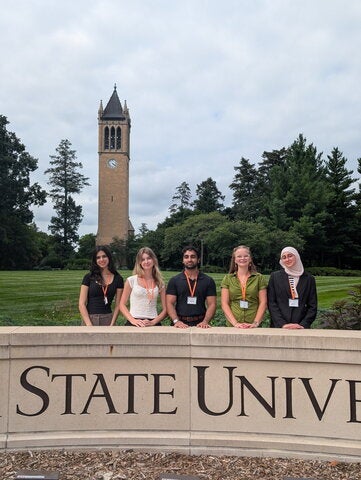
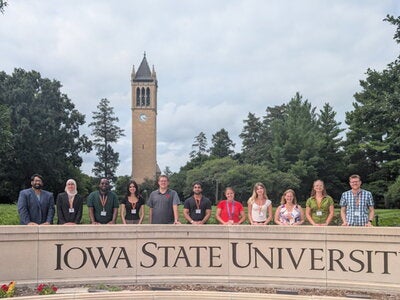
Eleven Illinois students and faculty researchers recently represented the university at the 2025 U.S. Conference on Teaching Statistics (USCOTS), held at Iowa State University. The delegation included undergraduates from multiple disciplines, including juniors Reem Kharfan (psychology), Samin Hemani (information systems), Mia Petrie (middle grade education) and seniors Madeline Hunt (statistics & psychology), and Bhuvan Kala (statistics & mathematics). Alongside the students also included statistics professors, Kit Clement, Julie Deeke, Kelly Findley, Christopher Kinson, Vimal Rao, and research collaborator and teaching associate at University Laboratory High School, Emily Buhnerkempe.
Organized by the Consortium for the Advancement of Undergraduate Statistics Education (CAUSE), USCOTS has been a biennial fixture since 2005. This year’s theme, “Useful Models,” encouraged attendees to explore statistical, pedagogical, and curricular frameworks that enhance teaching and learning. The conference featured keynote talks, breakout sessions, poster presentations, and technology demonstrations, all aimed at improving how statistics and data science are taught at every level.
Undergraduates Madeline Hunt and Bhuvan Kala joined hundreds of educators and peers from across the country to showcase how student-led research is helping transform statistics education. Their human-centered investigations and AI-driven projects demonstrate a new generation of scholars reshaping both pedagogy and practice. Hunt and Kala took time to share their experiences and provide insights on being a student researcher presenting at a national conference.
Hunt presented two projects examining how students engage with statistical concepts. One study, in collaboration with Hemani and professor Rao, explored how tolerance of uncertainty relates to statistical understanding. “What we found was that one’s ability to tolerate uncertainty is related to statistical understanding,” Hunt explained. “In fact, it precedes anxiety and attitudes towards statistics when predicting one’s understanding.” Drawn to its compelling intersection of psychological theory and statistical reasoning, Hunt joined the project last year as a reflection of her two programs of study.
Her second project investigated how introductory students interpret data visualizations commonly found in the media. After conducting and analyzing in-depth interviews, Hunt uncovered common misconceptions among the students, such as mistaking percent change for absolute values and misinterpreting rates versus totals. “This project taught me a lot about qualitative analysis,” she said. “I also enjoyed holding the interviews and talking to students.”
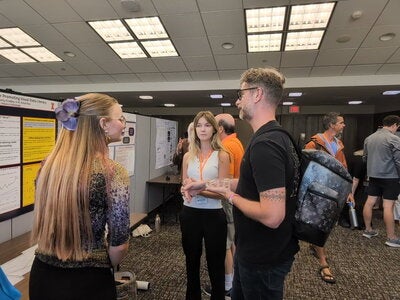
During the poster presentation, Hunt found herself speaking with Hadley Wickham, a prominent figure in the field and a leading voice in data science. Surrounded by leading figures in statistics and data science education, Hunt initially felt overwhelmed, but gradually found her footing as the nerves gave way to confidence. “I definitely suffered from imposter syndrome at first,” she admitted. “But that wore off the more I presented and the more people I spoke to.”
Preparing for USCOTS was transformative on its own. “Seeing everything come together in the poster was one of my favorite parts,” Hunt said. “It turns all the ideas and analyses into a physical form.” She noted that the experience not only sharpened her communication skills but also gave her the confidence to present her research to diverse audiences, regardless of background or expertise. “I gained so much experience presenting and speaking about my research,” she said. “I think I could truly talk about it with anyone now.”
Like Hunt, Kala brought interdisciplinary curiosity to USCOTS. Kala blended statistical insight with an interest in accessibility and emerging technologies for his project. In collaboration with Illinois statistics and psychology major Sanjana Gongati, Toronto Metropolitan University’s Laura Bandi, and professor Rao, Kala’s project, “Can Using AI Tools to Do Statistics Broaden Participation in STEM?”, explored how generative AI could lower barriers to statistical analysis and coding. “What if English is the only programming language we need to master?” he asked, reflecting on how intuitive prompting, whether through ChatGPT or a simple search, can democratize access to data science tools.
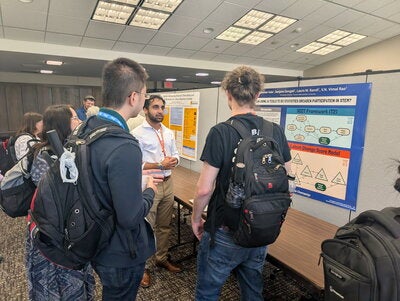
Kala’s journey sparked the idea. He noted how tools like AI helped him bridge gaps when learning to code or interpret complex methods. “I’ve always been intrigued by how we prompt not just with gen AI but with a simple Google search to get information,” he said. By comparing user prompts across platforms, Kala highlighted how these interfaces could empower students without extensive programming experience.
His experience at USCOTS extended far beyond the poster floor. Kala had long aspired to teach at the college level, but until the conference, wasn’t sure which pathway best aligned with his interests. Through conversations with faculty and fellow researchers, he discovered multiple avenues, such as pursuing graduate studies, teaching entry-level courses, or serving as an adjunct professor. “People truly want to see you succeed,” he said. “That guidance helped me realize there were real options, and people willing to help me make it happen.”
Presenting in front of an international audience felt intense, but exhilarating. “I definitely felt the scale of how many people my research was reaching,” Kala said. Meeting academics from across the globe reinforced the relevance of his work, and the welcoming nature of the community stood out. “Every single person I presented to was nothing short of supportive,” he noted. The encouragement, the genuine interest, and the diversity of perspectives made the experience feel both validating and inspiring.
For Kala, the biggest takeaway was the confidence he gained from stepping into a professional space and owning his voice. “You will 100% not regret it,” he said. “The experience you gain from presenting a poster at a conference will give you so much confidence. Everyone at this conference truly just wants to see you succeed. The people you meet are kind, have wonderful personalities, and it feels like you’re part of a family when you go there.”
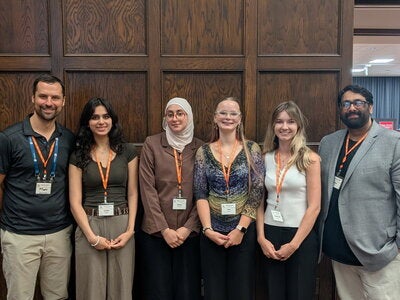
Multiple statistics faculty members who attended USCOTS emphasized how transformative conference experiences can be for students. Professor Vimal Rao described the impact as “nothing short of transformative,” stressing that supporting opportunities like this is a duty if we care about shaping a bright future. Professor Kelly Findley noted how conferences broaden students’ perspectives on statistical education and can even spark interest in teaching careers. For Professor Christopher Kinson, the value lies in the connections students make with peers, future collaborators, and the discipline itself. Professor Kit Clement praised USCOTS for its welcoming atmosphere, adding that many undergraduates became more excited about research after attending. Taken together, these reflections mirror what Hunt and Kala experienced firsthand.
Both Hunt and Kala say the experience was worthwhile and encourages others to pursue similar opportunities. Their advice to fellow undergraduates is simple and straightforward: “Absolutely go,” Hunt said. “It’s scary and new, but will be one of the biggest learning and growing experiences of your undergrad.” Kala agreed: “You won’t regret it. The experience you gain will give you so much confidence.”
As the field of statistics continues to evolve, conferences like USCOTS offer students not just a glimpse into the profession but a voice and a chance to be heard.
Photos appear courtesy of Vimal Rao
Aaron Thompson is a staff writer for the Department of Statistics. If you have news to share, please contact the Statistics News Group at stat-marcom@illinois.edu